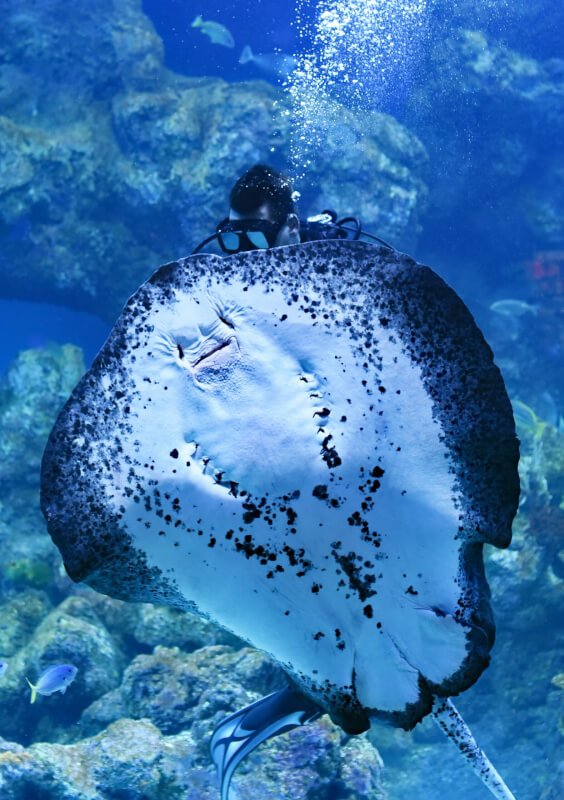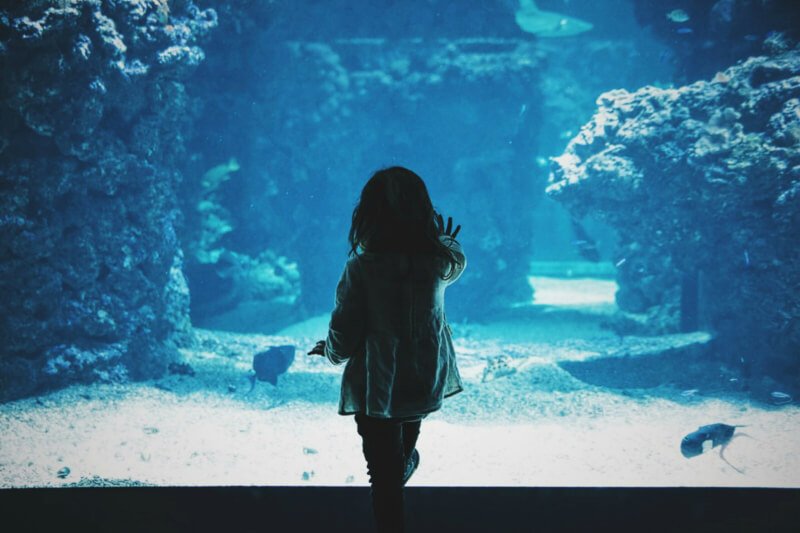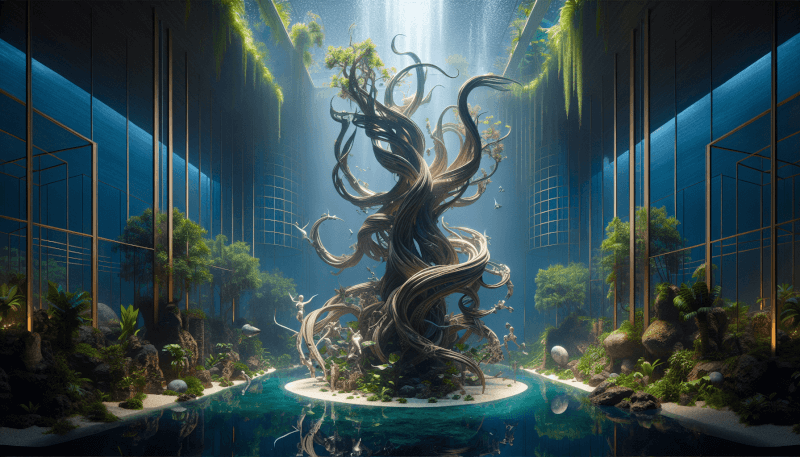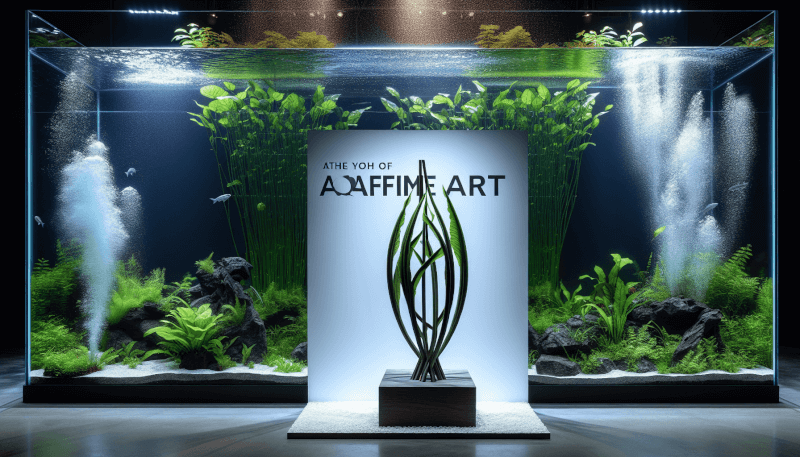Imagine creating a visual masterpiece that not only showcases the beauty of aquatic life but also captivates with a brilliant contrast against non-aquatic elements. In the world of aquarium aesthetics, the art lies in achieving a striking balance between these two worlds. By skillfully blending the fluidity of underwater elements with the solid grounding of non-aquatic features, you can elevate the visual appeal of any aquarium. Let us explore the secrets behind designing a captivating contrast that will leave both you and your aquatic companions in awe.

1. Choosing the right aquarium design
When it comes to designing your aquarium, there are a few factors you should consider. Firstly, think about the size and shape of the aquarium. The size will depend on the space you have available and the number of aquatic species you plan to keep. Additionally, the shape of the aquarium can vary from rectangular to round, and even custom designs like cylinder or hexagon shapes.
Once you have determined the size and shape, it’s important to select a design that complements the space where the aquarium will be placed. Consider the overall aesthetic of the room and choose a design that blends in harmoniously. You can opt for a minimalist and modern design for a sleek and clean look or go for a more ornate and decorative design for a touch of elegance.
Ensuring proper water circulation and filtration system is crucial for maintaining a healthy and thriving aquatic ecosystem. Look for aquarium designs that come with built-in filtration systems or choose separate filtration systems that suit the size of your aquarium. Proper water circulation is essential for oxygenating the water and preventing the buildup of harmful substances. Don’t overlook this aspect when selecting the right aquarium design.
2. Incorporating contrasting colors
One of the key elements in creating a visually striking aquarium is the use of contrasting colors. By incorporating both vibrant and neutral colors, you can achieve a balanced and eye-catching color palette. When choosing the colors, think about how they will complement both the aquatic and non-aquatic elements in your aquarium.
For the aquatic elements, vibrant colors can be achieved through the use of colorful fish, vibrant live plants, or vibrant artificial ornamentation. On the other hand, neutral colors like shades of green, brown, or gray can be used for non-aquatic elements like rocks, driftwood, or decorative statues. The contrast between these vibrant and neutral colors will create visual interest and depth in your aquarium.
Consider the color temperature and lighting effects when selecting your color palette. Warm colors like red, orange, or yellow create a cozy and inviting atmosphere, while cool colors like blue or green evoke a sense of tranquility. Experiment with different combinations to find the perfect balance that suits your personal preference and the overall ambiance of the room where the aquarium is placed.
3. Balancing natural and artificial elements
To create a visually appealing aquarium, it’s important to strike a balance between natural and artificial elements. Live plants and rocks are great choices to represent aquatic elements in your aquarium. They provide a sense of authenticity and mimic the natural habitat of the aquatic species you choose to keep. Additionally, live plants offer many benefits, such as oxygenation of the water and removal of excess nutrients.
Incorporating non-aquatic decorative items like driftwood or statues can add a touch of interest and personality to your aquarium. These items can serve as focal points or create a thematic design. When selecting non-aquatic elements, choose items that complement the overall color palette and aesthetic of your aquarium. Keep in mind that while these items are not part of the aquatic ecosystem, they should still contribute to the overall harmony and balance of the design.
Finding the right balance between natural and artificial elements may require some experimentation and adjustments. Be open to trying out different combinations and arrangements until you achieve the desired effect. Remember, the goal is to create a harmonious and visually appealing environment for both the aquatic species and the viewers.
4. Choosing suitable aquatic species
When selecting the aquatic species for your aquarium, it’s important to choose ones that stand out visually. Consider the size, color, and behavior of the species before making a decision. Some fish species have vibrant colors and unique patterns, while others may have interesting behaviors like schooling or territorial displays. Choose species that complement the overall design and create an engaging visual experience.
Before introducing any species to your aquarium, it’s essential to research their compatibility with other species. Some fish may exhibit aggressive behavior towards certain types of fish, which can disrupt the harmony of your aquarium. Ensure that the species you choose can coexist peacefully and have similar environmental requirements.
It’s also worth considering the number of species you plan to keep as overcrowding can lead to stress and health issues for the aquatic inhabitants. Strike a balance between having enough variety to create visual interest and maintaining a suitable living environment for each species. Researching the specific needs and requirements of different aquatic species will help you make informed decisions when selecting the right species for your aquarium.

5. Selecting non-aquatic items with contrasting textures
In addition to contrasting colors, incorporating contrasting textures can further enhance the visual appeal of your aquarium. Experiment with different textures to add depth and variation to your design. Consider using smooth stones, rough driftwood, or metallic accents to create visual interest and contrast.
By providing surfaces with varying levels of reflection and sheen, you can create a dynamic and visually captivating environment. Some ornaments or decorative items may possess a shiny or reflective surface, while others may have a more matte texture. Combining these different textures will add dimension to your aquarium and make it more visually engaging.
When selecting non-aquatic items with contrasting textures, keep in mind the practical aspects as well. Ensure that the items are safe for the aquatic species and do not pose any risk of injury or contamination to the water. Maintaining a balance between aesthetics and functionality is crucial to creating a beautiful and sustainable aquarium.
6. Creating focal points with aquatic and non-aquatic elements
To draw attention and create a focal point in your aquarium, consider placing a centerpiece aquarium ornament that stands out. This can be a large decorative item like a rock formation, a shipwreck, or a unique piece of driftwood. The centerpiece should complement the overall theme and color scheme of your aquarium.
In addition to a centerpiece, you can also use contrasting elements to draw attention to specific areas within your aquarium. For example, placing vibrant live plants near neutral-colored rocks or placing colorful fish against a backdrop of subdued colors can create visually striking combinations. Experiment with different arrangements and combinations to find the most visually appealing focal points for your aquarium.
The key to creating focal points is to strategically arrange visually striking combinations of plants, rocks, and decorative items. By carefully considering the placement and proportion of each element, you can create a visually balanced and captivating aquarium design.

7. Incorporating depth and dimension
Creating a sense of depth and dimension in your aquarium is essential for a visually captivating design. One way to achieve this is by using a combination of foreground, midground, and background elements. Foreground elements can be plants or decorative items placed at the front of the aquarium, midground elements can be larger plants or rocks positioned in the middle, and background elements can be taller plants or decorative items placed at the back.
Arranging plants and objects in a way that creates an illusion of depth will enhance the visual contrast and make your aquarium appear larger and more immersive. Consider using perspective techniques, such as placing taller plants or objects towards the back and gradually decreasing in height towards the front. This will give the perception of distance and depth.
Additionally, creating variations in height, shape, and texture will further enhance the sense of dimension in your aquarium. Experiment with different combinations and arrangements to find the most visually appealing layout that creates depth and dimension.
8. Paying attention to the aquarium backdrop
The backdrop of your aquarium plays an important role in enhancing the contrast between aquatic and non-aquatic elements. Choose a backdrop that complements the overall design and colors of your aquarium. Consider using textured or patterned backgrounds to create visual interest. These can be purchased as adhesive backings or custom backgrounds.
When selecting a backdrop, ensure that it does not overpower the focal point of the aquarium. It should serve as a backdrop, not a distraction. The goal is to create a seamless transition between the aquatic and non-aquatic elements, with the backdrop enhancing the overall visual impact.
The backdrop can also affect the lighting effects in your aquarium. Experiment with different backdrops to see how they interact with the lighting and color temperature. Some backdrops may enhance the vibrant colors of the aquatic elements, while others may create a more subdued and natural ambiance. Choose a backdrop that complements the overall aesthetic and enhances the contrast between aquatic and non-aquatic elements.

9. Creating a sense of movement
To bring your aquarium to life, incorporate elements that create a sense of movement. This can be achieved through both aquatic and non-aquatic objects. For example, air pumps or waterfalls can be used to create water movement, mimicking natural flow. These not only provide visual interest but also help oxygenate the water, benefiting the aquatic species.
Non-aquatic objects can also give the illusion of movement. Consider incorporating kinetic sculptures or decorative items with flowing shapes that evoke a sense of motion. Positioning plants and objects in a way that suggests natural flow and motion will further enhance the sense of movement in your aquarium.
When incorporating elements that create movement, ensure that they are safe for the aquatic species and do not disrupt their natural behavior or well-being. Balance the desire for movement with the need for a stable and comfortable environment for the aquatic inhabitants.
10. Regular maintenance and upkeep
Maintaining the visual appeal and contrast of your aquarium requires regular maintenance and upkeep. Keeping the aquarium clean and free from debris is paramount. Regular water changes, removal of excess algae, and routine cleaning of filters and pumps will help maintain the clarity of the water and prevent any build-up that could affect the aesthetics.
Pruning and trimming live plants regularly is essential to maintain their visual appeal. Overgrown plants can obstruct the view and overshadow other elements in your aquarium. Trimming also encourages healthy growth and prevents plants from encroaching on each other’s space.
Periodically replacing or rearranging non-aquatic items can refresh the contrast and visual appeal of your aquarium. Over time, certain decorative items or ornaments may lose their appeal or become covered in algae. By refreshing the non-aquatic elements in your aquarium, you can revitalize the overall design and ensure it continues to be visually striking.
In conclusion, designing a visually striking contrast between aquatic and non-aquatic elements in your aquarium requires careful consideration of various factors. From selecting the right aquarium design to choosing suitable aquatic species and incorporating contrasting colors and textures, each aspect plays a crucial role in creating an aesthetically pleasing environment. By following the tips outlined in this article and regularly maintaining your aquarium, you can create a captivating and harmonious display that brings joy and tranquility to both you and your aquatic inhabitants.


